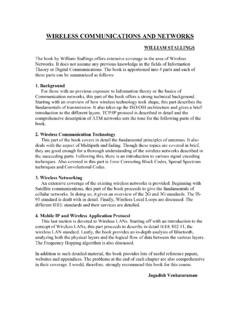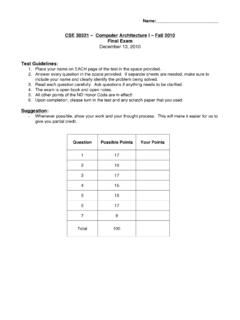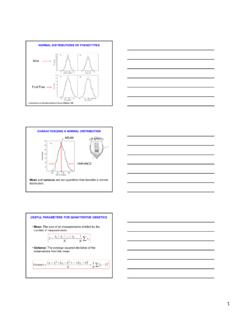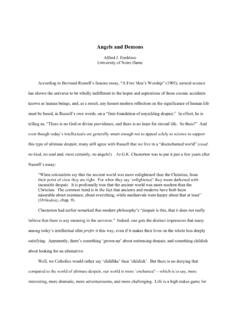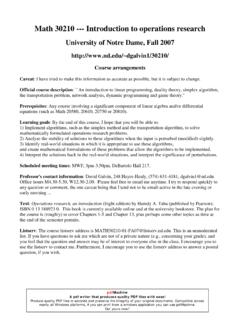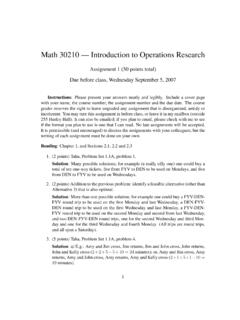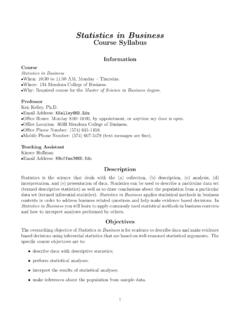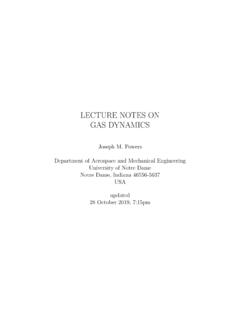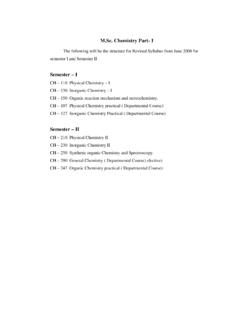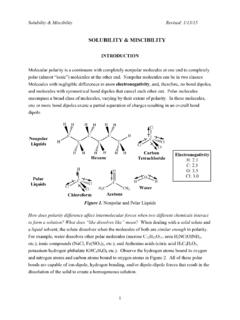Transcription of CHAPTER 4: IMPERFECTIONS IN SOLIDS
1 CHAPTER 4: IMPERFECTIONS IN SOLIDS ISSUES TO - What types of defects arise in SOLIDS ? - Can the number and type of defects be varied and controlled ? - How do defects affect material properties? - Are all defects undesirable? REAL CRYSTALS Real crystals are never perfect: there are always defects! Controlling the defects is one of the main goal of materials science and engineering! IMPERFECTIONS in SOLIDS The properties of materials are profoundly influenced by the presence of IMPERFECTIONS . It is important to have knowledge about the types of IMPERFECTIONS that exist and the roles they play in affecting the behavior of materials. Types of IMPERFECTIONS Point defects Vacancy atoms Self-Interstitial atoms Impurities: Substitutional and Interstitial atoms Line defects Dislocations Area defects Grain Boundaries Dimensional Ranges of Different Classes of Defects Point Defects (I) Vacancies: vacant atomic sites in a structure.
2 Vacancydistortion of planesself-interstitialdistortion of planesSelf-Interstitials: "extra" atoms positioned between atomic sites Point Defects (II) in principle you can eliminate all of these except vacancies vacancies arise from thermodynamics (entropy) Substitutional impurity impurity atom in lattice Interstitial impurity impurity atom not in regular lattice site Equilibrium Concentration: Vacancies Each lattice site is a potential vacancy site where: N - is number of sites ND - is number of defects QD is activation energy T is a temperature k Boltzmann's constant x 10-23 J/atom K N D N = exp - Q D k T N = r x (NA/A) x V where: r - density; A atomic mass V volume and NA Avogadro number ( x 1023 atom/mol) QD x 10 -5 eV/atom-K 1 eV = 10-19 J We can get Q from an experiment Plot data in the so-called Arrhenius form: 1/T N ND ln -QD /k slope T exponential dependence!
3 Measuring Activation Energy N ND typically QD is ~1 eV = 10-19 J at room temperature, ND/N is ~10-17 D Equilibrium Concentration of Vacancies Find the equilibrium number of vacancies in 1m3 of Cu at 1000 C. ACu = rCu = g / cm 3 QD = NA = x 10 23 atoms/mole x 10 -5 eV/atom-K 1273K ND N = exp - Q D k T = 10 -4 Answer: For 1 m3 , N = r NA/Acu 1m3 = 8 1028 sites Low energy electron microscope view of a (110) surface of NiAl. Increasing T causes surface island of atoms to grow. Why? The equilibrium vacancy concentration increases via atom motion from the crystal to the surface, where they join the island. ( McCarty, Nobel, and Bartelt, "Vacancies in SOLIDS and the Stability of Surface Morphology",Nature, Vol.)
4 412, pp. 622-625 (2001). Image mm by mm.) Copyright (2001) Macmillan Publishers, Ltd. EQUILIBRIUM VACANCY CONCENTRATION 12 Point Defects in Polymers Defects due in part to chain packing errors and impurities such as chain ends and side chains Adapted from Fig. , Callister & Rethwisch 3e. Growth and synthesis Impurities may be added to the material during synthesis Thermal & thermochemical treatments and other stimuli Heating to high temperature and quench Heating in reactive atmosphere Heating in vacuum in oxides it may lead to loss of oxygen Etc. Plastic Deformation Ion implantation and irradiation Electron irradiation (typically >1 MeV) Direct momentum transfer or during relaxation of electronic excitations) Ion beam implantation (As, B etc.
5 Neutron irradiation Methods of producing point defects Alloys An alloy is a combination, either in solution or compound, of two or more elements, at least one of which is a metal. An alloy with two components is called a binary alloy; one with three is a ternary alloy; one with four is a quaternary alloy. The result of alloying is a metallic substance with properties different from those of its components. Example: Steel is a metallic alloy whose major constituent is iron. One classical definition is that steels are iron-carbon alloys with up to carbon. With the increased carbon, steel is harder and has a much higher tensile strength than iron, but is also more brittle. solid Solutions (I) The extent to which the components of an alloy are miscible depends on the interaction between the atoms: If strong mutual attraction occurs, a single crystal of a different phases can form, such as in intermetallic compounds If there is little difference between like and unlike bonds, then a solid solution can occur, over a wide range of elemental compositions If the species do not tend to bond to each other, then separate phases will form with limited or zero miscibility (pseudo-alloys).
6 Types of solid Solutions The name substitutional- of this solid solution tells you exactly what happens as atoms of the parent metal are replaced or substituted by atoms of the alloying metal. In interstitial solid solutions the atoms of the parent or solvent metal are bigger than the atoms of the alloying or solute metal. In this case, the smaller atoms fit into interstices spaces between the larger atoms. In both cases the overall atomic structure is virtually unchanged. Range of solubility in Substitutional solid Solutions Substitutional solid Solutions can exist over a limited composition range limited solubility ; exist over the whole composition range full solubility . HUME ROTHERY RULES: basic conditions for appreciable solubility Sizes: should not differ by more than 14%; structures: same for pure metals; : The atoms should have similar electronegativity, or compounds will form; : If (1) -(3) are favorable, then the metal of lower valence will dissolve more in crystal structure of the higher valence metal than vice versa.
7 Note: Not all alloys systems that fit these rules will form appreciable solid solutions Example I Cu-Ni Binary System Both metals are completely soluble in each other. The a phase is a substitutional solid solution. This occurs because both the Cu and Ni form FCC structures, and have close: - atomic radii ( and ), - electronegativity ( and ) - valence (+2). Cu and Ni show very different physical properties in their pure states, and the a phase provides a continuous change between the extremes. 20 4 0 6 0 8 0 10 0 0 100 0 110 0 120 0 130 0 140 0 150 0 160 0 T( C) L (liquid) a (FCC solid solution) A(1100,60) B (1250,35) wt. % Ni Example II Cu-Ag Binary System In fact, the Cu-Ag phase diagram shows that solubility of only ~8 Ag can be achieved at high T in the Cu-rich alloy Interstitial solid Solutions: Example Alloying with smaller atoms (C, N) Small atoms fill in interstitial spaces These atoms deform crystal lattice and introduce internal stress Steel is an interstitial iron-carbon alloy Iron: BCC and FCC atomic radii: BCC - FCC - valence +2 or +3 Carbon: Hex.
8 Cubic atomic radii: valence +4 The high temperature form of iron (austenite, FCC) can dissolve a max. of ~ carbon at 1148 C. The lower temperature form (ferrite, BCC) can only dissolve a max. of % at 727 C Low energy electron microscope view of a (111) surface of Cu. Sn islands move along the surface and "alloy the Cu with Sn atoms, to make "bronze". The islands continually move into "unalloyed" regions and leave tiny bronze particles in their wake. Eventually, the islands disappear. Reprinted with permission from: Schmid, Bartelt, and Hwang, "Alloying at Surfaces by the Migration of Reactive Two-Dimensional Islands", Science, Vol. 290, No. 5496, pp. 1561-64 (2000).
9 Field of view is mm and the temperature is 290K. Alloying a Surface Vacancy atoms Interstitial atoms Substitutional atoms Dislocations Grain Boundaries Point defects Line defects Planar Defects TYPES OF IMPERFECTIONS Strength of a Material Based on the bond strength most materials should be much stronger than they are From CHAPTER 2 we know that the strength for an ionic bond should be about 1 GPa More typical strength is 200 MPa Why? Materials must not usually fail by breaking bonds!! 26 are line defects; slip between crystal planes result when dislocations move; produce permanent (plastic) deformation. Dislocations: Schematic of dislocation slip Line Defects Deformation of ductile materials occurs when a line defect (dislocation) moves (slip) through the material slip steps Dislocations are linear defects, lead to the atom misalignment cause slip between crystal plane when they move produce permanent (plastic) deformation.
10 Dislocation Types: - Edge dislocation - Crew dislocation - Mixed dislocation Edge dislocation centers around the edge dislocation line that is defined along the end of the extra half-plane of atoms EDGE DISLOCATION Distortion to the lattice decreases with distance away from dislocation line; Burgers vector, b, defines the magnitude and direction of the deformation; For edge dislocation b and dislocation line are perpendicular Burger Vector A Burger depends on the viewing direction The choice of positive viewing direction: clockwise Burgers circuit Burger s vector, b: measure of lattice distortion SCREW DISLOCATION Screw dislocation is a ramped step in crystal planes Burgers vector which defines the direction of the atoms displacement for a screw dislocation is parallel to the line of the dislocation Harder to visualize than edge dislocations Open circles upper half atoms solid circles lower half atoms Connecting looks like a screw Deformation When a shear force is applied to a material, the dislocations move Real materials have lots of dislocations, therefore the strength of the material depends on the force required to make the dislocation move, not the bonding energy Dislocation motion requires the successive bumping (slip)
